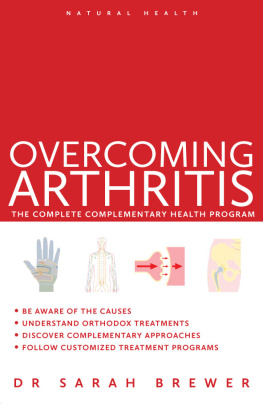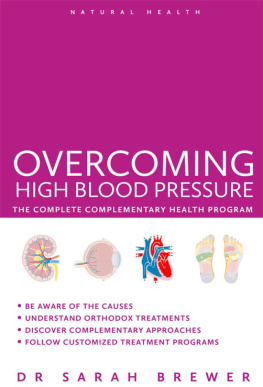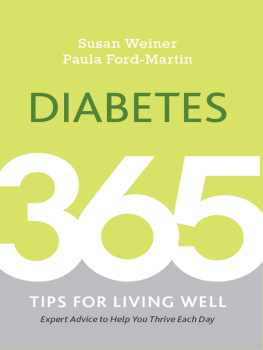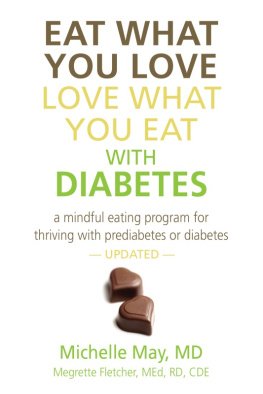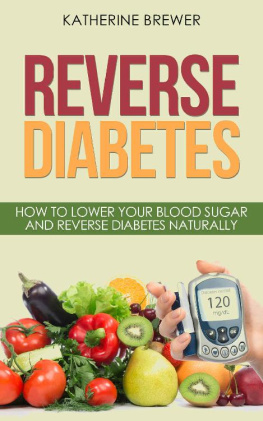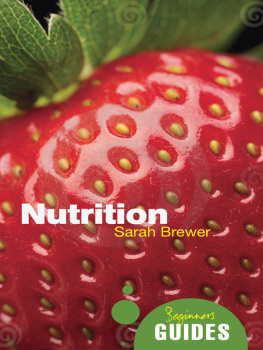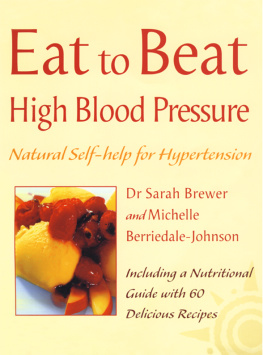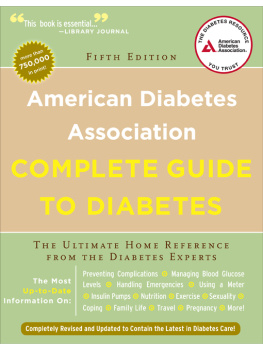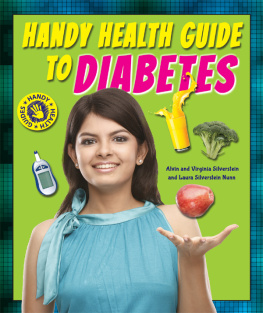Dr. Sarah Brewer - Overcoming Diabetes: A Doctors Guide to Self-Care
Here you can read online Dr. Sarah Brewer - Overcoming Diabetes: A Doctors Guide to Self-Care full text of the book (entire story) in english for free. Download pdf and epub, get meaning, cover and reviews about this ebook. year: 2012, publisher: Watkins Media, genre: Home and family. Description of the work, (preface) as well as reviews are available. Best literature library LitArk.com created for fans of good reading and offers a wide selection of genres:
Romance novel
Science fiction
Adventure
Detective
Science
History
Home and family
Prose
Art
Politics
Computer
Non-fiction
Religion
Business
Children
Humor
Choose a favorite category and find really read worthwhile books. Enjoy immersion in the world of imagination, feel the emotions of the characters or learn something new for yourself, make an fascinating discovery.
- Book:Overcoming Diabetes: A Doctors Guide to Self-Care
- Author:
- Publisher:Watkins Media
- Genre:
- Year:2012
- Rating:3 / 5
- Favourites:Add to favourites
- Your mark:
- 60
- 1
- 2
- 3
- 4
- 5
Overcoming Diabetes: A Doctors Guide to Self-Care: summary, description and annotation
We offer to read an annotation, description, summary or preface (depends on what the author of the book "Overcoming Diabetes: A Doctors Guide to Self-Care" wrote himself). If you haven't found the necessary information about the book — write in the comments, we will try to find it.
Overcoming Diabetes: A Doctors Guide to Self-Care — read online for free the complete book (whole text) full work
Below is the text of the book, divided by pages. System saving the place of the last page read, allows you to conveniently read the book "Overcoming Diabetes: A Doctors Guide to Self-Care" online for free, without having to search again every time where you left off. Put a bookmark, and you can go to the page where you finished reading at any time.
Font size:
Interval:
Bookmark:
DIABETES

Worldwide, an estimated 246 million adults live with diabetes, with another two people receiving the diagnosis every ten seconds. The number of people with Type 1 diabetes is increasing at the alarming rate of three percent per year, while Type 2 diabetes is becoming so prevalent that, in some communities, half of all adults over the age of 35 are affected. Each year, another seven million people develop diabetes, and its estimated that, by the year 2025, as many as 380 million people will have it.
Diabetes is a condition in which blood glucose levels are abnormally high because the body can no longer use glucose adequately as a fuel. The use of glucose as a fuel requires insulin, a hormone made in the pancreas. Around one in ten people with diabetes have Type 1 diabetes in which there is a severe lack of insulin. The vast majority have Type 2 diabetes, however, in which some insulin is made, but not enough to meet the bodys needs. There may even be a higher than normal level of insulin in the body this is because the body becomes resistant to the action of insulin and the pancreas responds by producing more and more. Insulin resistance is largely due to lack of exercise, overweight and obesity.

The information and advice given in this book is for general information only. It is not intended to replace individual advice from your doctor, and is not intended for women who are pregnant or who develop gestational diabetes. This book takes an holistic approach, and is designed to complement the treatments your doctor prescribes. If youre taking medication tablets or injections for diabetes, follow your doctors instructions carefully on how often to take your medication. If you want to make dietary changes, or to start taking supplements, discuss this with your doctor. You must be aware of how to monitor your blood glucose, and be confident in adjusting your medication if your blood glucose control improves (or worsens). Dont stop taking prescribed medication without your doctors permission. Once your glucose control improves, your doctor should be willing to adjust your medication under supervision.
Unfortunately, for every person who knows they have diabetes, there is someone who is unaware they have the condition. Diabetes is associated with a number of unpleasant complications that claim more than three million lives every year one death every ten seconds. This is a tragedy given that most cases of Type 2 diabetes are preventable, and many people with raised glucose levels can revert to normal glucose control with the right dietary and lifestyle interventions.
Glucose is a very reactive chemical that attacks and binds to proteins in the circulation, and in organs such as the kidneys and eyes. This is why, in the long term, a high blood glucose level can cause the complications of diabetes: heart attack, stroke, kidney failure and loss of eyesight. By maintaining good control of glucose levels, the risk of developing complications can be significantly reduced.
If you have Type 2 diabetes, then losing excess weight, exercising and following a low-glycemic, wholefood diet can improve your insulin secretion, and reduce your bodys resistance to its effects. Many supplements, herbal remedies, complementary therapies and relaxation techniques can improve your glucose control, too. These measures are often enough to control glucose levels without the need for medication.
If you have Type 1 diabetes, theres little you can do to increase your natural insulin production, but dietary and lifestyle changes can improve your overall health, reduce your long-term risk of complications or alleviate the symptoms of complications if you develop them.
In this book I provide dietary and lifestyle information that will help you improve your glucose control and reduce your risk of diabetes complications. Because everyone is different, and no diet and lifestyle plan will suit all individuals, I have devised three different approaches: a gentle, a moderate and a full-strength program, one of which is likely to suit you. To help you work out which plan is right for you, complete the detailed questionnaire on pages 109110. This will help to point you in the right direction.
For people who want to take things slowly, the gentle program introduces you to healthy eating principles such as cutting back on refined carbohydrates, cooking without salt, eating more fruit, vegetables and fish, and lowering your consumption of red meat. Food supplements are suggested at the lowest level that research suggests can still have a significant beneficial effect on your health. The gentle program gets you doing abdominal exercises and walking briskly, and introduces you to complementary approaches that can improve glucose control, boost circulation and help you relax. These include yoga, massage, meditation, magnetic therapy, homeopathy and aromatherapy.
For those who are more adventurous, or who already follow a relatively healthy diet and lifestyle, the moderate program introduces you to a low glycemic way of eating based on the Mediterranean diet, which increases your intake of garlic, olive oil, fruit, vegetables and fish. Food supplements are suggested at more therapeutic doses, and the exercise program is more intensive. In addition, I introduce you to complementary approaches such as Ayurvedic medicine, breathing exercises and reflexology.
For those wishing to follow the full-strength program, the low glycemic dietary changes I suggest are based on one of the healthiest ways of eating in the world the Japanese diet. This includes exotic dishes such as sashimi (raw fish), medicinal mushrooms and sea vegetables. Food supplements are suggested at the higher end of the therapeutic dose range, and you are introduced to complementary techniques, such as shiatsu acupressure, acupuncture, and a series of yoga poses known as the salute to the sun.

Throughout this book I have included boxes that highlight useful, interesting or important pieces of information. Each box bears a symbol (see below). The arrow symbol indicates that a box contains practical instructions. The plus sign means that the box contains additional information about the subject being discussed or about asthma in general. The exclamation mark indicates a warning or a caution.
There are many myths about diabetes, such as: its caused by eating too much sugar and Type 2 diabetes is less serious than Type 1 diabetes. On the following pages I give you the facts about diabetes and explain the difference between the two main types of the condition. In both Type 1 and Type 2 diabetes, the body is unable to process glucose in the normal way. This means that even when sugary foods are eaten, the body cannot access the glucose properly and is deprived of its main energy source. If you have Type 1 diabetes, this can lead to symptoms such as rapid weight loss, because your body starts to break down fat and muscle. If you have Type 2 diabetes, your body remains able to access some glucose, but a significant amount stays in your bloodstream. This has long-term consequences for your health. The correct diagnosis and monitoring of diabetes is very important from the moment you are diagnosed, you can take steps to optimize your future health. Most importantly, you can learn to manage your blood glucose effectively. This will help to prevent or delay many of the long-term complications of diabetes that can damage your heart, blood vessels, nerves and kidneys. The treatment of diabetes varies some people need insulin or tablets; others can rely on a healthy diet and lifestyle.
Font size:
Interval:
Bookmark:
Similar books «Overcoming Diabetes: A Doctors Guide to Self-Care»
Look at similar books to Overcoming Diabetes: A Doctors Guide to Self-Care. We have selected literature similar in name and meaning in the hope of providing readers with more options to find new, interesting, not yet read works.
Discussion, reviews of the book Overcoming Diabetes: A Doctors Guide to Self-Care and just readers' own opinions. Leave your comments, write what you think about the work, its meaning or the main characters. Specify what exactly you liked and what you didn't like, and why you think so.


